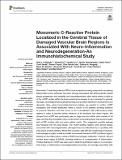Por favor, use este identificador para citar o enlazar a este item:
http://hdl.handle.net/10261/260345COMPARTIR / EXPORTAR:
 SHARE SHARE
 CORE
BASE CORE
BASE
|
|
| Visualizar otros formatos: MARC | Dublin Core | RDF | ORE | MODS | METS | DIDL | DATACITE | |

| Título: | Monomeric C-Reactive Protein Localized in the Cerebral Tissue of Damaged Vascular Brain Regions Is Associated With Neuro-Inflammation and Neurodegeneration-An Immunohistochemical Study |
Autor: | Al-Baradie, Raid S.; Pu, Shuang; Liu, Donghui; Zeinolabediny, Yasmin; Ferris, Glenn; Sanfeliu, Coral CSIC ORCID; Corpas, Rubén CSIC ORCID; García-Lara, Elisa CSIC ORCID; Alsagaby, Suliman A.; Alshehri, Bader M.; Abdel-hadi, Ahmed M.; Ahmad, Fuzail; Moatari, Psalm; Heidari, Nima; Slevin, Mark CSIC ORCID | Fecha de publicación: | 16-mar-2021 | Editor: | Frontiers Media | Citación: | Frontiers in Immunology 12: 644213 (2021) | Resumen: | Monomeric C-reactive protein (mCRP) is now accepted as having a key role in modulating inflammation and in particular, has been strongly associated with atherosclerotic arterial plaque progression and instability and neuroinflammation after stroke where a build-up of the mCRP protein within the brain parenchyma appears to be connected to vascular damage, neurodegenerative pathophysiology and possibly Alzheimer's Disease (AD) and dementia. Here, using immunohistochemical analysis, we wanted to confirm mCRP localization and overall distribution within a cohort of AD patients showing evidence of previous infarction and then focus on its co-localization with inflammatory active regions in order to provide further evidence of its functional and direct impact. We showed that mCRP was particularly seen in large amounts within brain vessels of all sizes and that the immediate micro-environment surrounding these had become laden with mCRP positive cells and extra cellular matrix. This suggested possible leakage and transport into the local tissue. The mCRP-positive regions were almost always associated with neurodegenerative, damaged tissue as hallmarked by co-positivity with pTau and β-amyloid staining. Where this occurred, cells with the morphology of neurons, macrophages and glia, as well as smaller microvessels became mCRP-positive in regions staining for the inflammatory markers CD68 (macrophage), interleukin-1 beta (IL-1β) and nuclear factor kappa B (NFκB), showing evidence of a perpetuation of inflammation. Positive staining for mCRP was seen even in distant hypothalamic regions. In conclusion, brain injury or inflammatory neurodegenerative processes are strongly associated with mCRP localization within the tissue and given our knowledge of its biological properties, it is likely that this protein plays a direct role in promoting tissue damage and supporting progression of AD after injury. | Versión del editor: | http://dx.doi.org/10.3389/fimmu.2021.644213 | URI: | http://hdl.handle.net/10261/260345 | DOI: | 10.3389/fimmu.2021.644213 | Identificadores: | doi: 10.3389/fimmu.2021.644213 e-issn: 1664-3224 |
| Aparece en las colecciones: | (IIBB) Artículos |
Ficheros en este ítem:
| Fichero | Descripción | Tamaño | Formato | |
|---|---|---|---|---|
| fimmu-12-644213.pdf | 3,2 MB | Adobe PDF |  Visualizar/Abrir |
CORE Recommender
PubMed Central
Citations
11
checked on 28-abr-2024
SCOPUSTM
Citations
15
checked on 23-abr-2024
WEB OF SCIENCETM
Citations
13
checked on 28-feb-2024
Page view(s)
24
checked on 30-abr-2024
Download(s)
44
checked on 30-abr-2024

